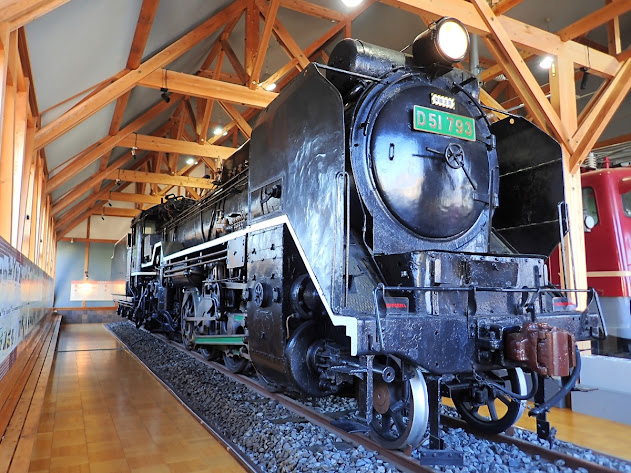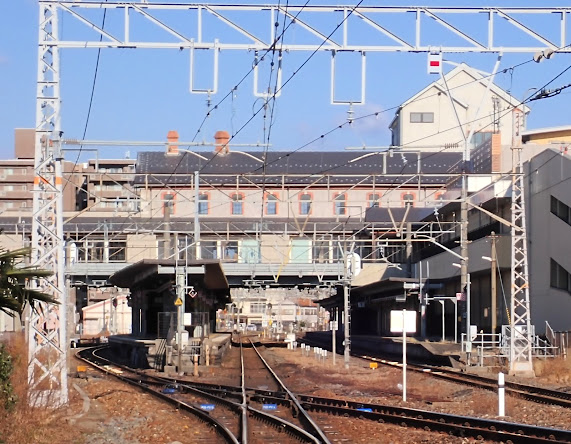Looking back at the history of railways in Japan, the first railway line was opened between Yokohama and Shinbashi in 1872.
After that, the railway continued to expand and in 1882, the first Nagahama Station was opened as a connecting station for a steamship on Lake Biwa and as the starting point for the Hokuriku Line. This former Nagahama Station building is a two-storey British style building, as seen in the photo below. In fact, this is the Japan's oldest train station building still in existence. It is located in Nagahama City, Shiga Prefecture, Japan.
In many cases, old station buildings would be torn down when new ones were built at the same location, so the old station buildings are often not preserved. In the case of Nagahama Station, however, the old station building still exists.
This is due to the fact that a new station building was built a little distance from here because the steamships used as a railway ferry ended their historical mission, I suppose. Since then, this old station had been used as a warehouse and as a result it was saved from demolition.

Passengers getting off the train transferred a steamship sailing on Lake Biwa in order to go from Nagahama to Kyoto, Osaka. At that time, a steamship departed from the pier next to the station building. Steamships were used as an alternative transportation until the construction of new railway line. After the completion of the new railway line connecting Nagahama with Kyoto, Osaka area in 1889, this railway station finished its mission in 1902 after only 20 years of operation and the new station building was built at the place where the current station stands. 
In 1958, it was designated a railway memorial as
the oldest existing station building, and in 2005 it was designated a Shiga Prefectural Tangible Cultural Property.
Adjacent to the old Nagahama station building, there are two museums concerning the railway. We call them the Nagahama railway square as a whole. The real steam locomotive and electric locomotive are displayed in one of the museums. In another museum, the ceiling is designed characteristically. I'll show it later.
Station Hall that was also used as the waiting room for the third-class passengers.
Ticket booth and passengers at that time. Timetable and fare table are raised over the booth. According to the timetable, when this station started operation in 1882,the trains went back and forth between Nagahama and Yanagase, a temporary terminal, total twice a day, each in the morning and in the afternoon. Two years later, the railway line was extended as far as to Tsuruga in Fukui Prefecture. At that time, the
Meiji government placed emphasis on connecting Kyoto and Tsuruga by railway.
The entrance to the waiting room for the first- and second-class passengers.
I took a quick peek into the door. By the way, fireplaces were equipped in each room.
The first-class or the second-class passengers sitting on a velvet long chair. Probably they were waiting for the steamship on Lake Biwa. The waiting room was luxurious compared to the third-class, what do you think?
By the way, two steamships connected the Nagahama port and the Otsu port via Lake Biwa 3 times a day, and it was said that it took approximately three and a half hours.
According to the timetable displayed on the wall, the last ferry service for the Nagahama port was 10 p.m. So, it would arrive at Nagahama at 1:30 a.m.
There were apparently 28 traveller's inns around the Nagahama station at the golden age, so passengers probably rested there until the first train. I can imagine how lively it must have been at the time.
However, this ferry service finished its mission for 7 years when the new railway line began operations in 1889.
Stationmaster's Office. The portrait in a frame is the first Nagahama stationmaster. Replica of his uniform is displayed in a transparent box. By the way, he eventually became the first Tokyo stationmaster about 30 years later.
This is the current JR Nagahama station building using the older station as a motif. The oldest Train station is just 3 minutes' walk from the west exit of JR Nagahama Station.
By the way, it takes about 70 minutes from Kyoto to Nagahama by a conventional line.
As mentioned earlier, behind the old Nagahama station building, there are two museums concerning the railway. The real steam locomotive and electric locomotive are displayed in one of the museums. Those locomotives had been active before and after the electrification of the Hokuriku railway line.
This is a D51 type steam locomotive, a famous steam locomotive known by the nickname "Degoichi". This D51 had been used to run commercially until 1970.
At that time, Nagahama Station was the terminus of two lines and worked as a switchback station. So, in this railway museum, the wooden made ceiling is arched to image a European railway terminus. In this museum, the history of railway is explained, especially on why the railway construction between Nagahama and Tsuruga was given priority to other areas in Japan.
This railway switch was used for about 80 years within Nagahama Station. It is the oldest surviving railway switch. In 1961, it was designated as a Railway Memorial Object.
At first as an important railway switch at the junction of two railway lines from 1882 to 1899 and for other purposes afterward. The Railway Bureau at the time imported the parts made by Cammell Co. in the UK, and they were assembled in Kobe, Japan in 1881.
I took these photos on January 25th, 2025. Last photo was taken on February 13th.
Reference: Tourist information pamphlet of Nagahama Railway Museum














Comments
Post a Comment